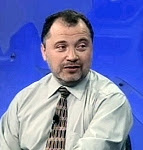Russian Situation Normal, All Fouled Up
 Writing in the Moscow Times Nikolai Petrov (pictured, left), scholar in residence at the Carnegie Moscow Center, exposes the utter sham of Russian domestic investment. On the one hand, Russia attempts huges projects it cannot possibly realize. On the other, these insane charades draw investment away from the vast majority of the country where it is desperately needed. In other words, welcome to the neo-Soviet Union.
Writing in the Moscow Times Nikolai Petrov (pictured, left), scholar in residence at the Carnegie Moscow Center, exposes the utter sham of Russian domestic investment. On the one hand, Russia attempts huges projects it cannot possibly realize. On the other, these insane charades draw investment away from the vast majority of the country where it is desperately needed. In other words, welcome to the neo-Soviet Union.
At a recent economic forum in Krasnoyarsk, estimates of total expected investment in Russia's economy by the year 2020 were more than impressive: The cumulative total in planned investment projects with price tags of $100 million or more could reach $450 billion. Oil and gas projects are set to account for as much as half of these funds, with another one-fifth earmarked for transportation and one-sixth for electrical generation. Two-thirds of the total are slated for projects in locations to the east of the Urals, which is home to only a little more than one quarter of the country's population.
The disparities are even greater if the potential investment is broken down by region. A mere six of the country's 88 regions account for more than half of all possible investment funding, standing to receive upward of $15 billion each. These are the Sakhalin, Krasnoyarsk, Yakutia, Irkutsk and Murmansk regions and the Yamalo-Nenets autonomous district. On the other hand, there are 25 regions not slated to receive any investment funding whatsoever. The investment in European Russia may be inadequate to maintain existing activity, but that east of the Urals should allow for the expansion of production.
Focusing on projects valued at $100 million or higher significantly distorts both the general picture and the view in particular regions and economic sectors. This almost completely ignores the rapidly expanding food, light industry, heavy machinery and high-tech sectors of the economy. The planned investment in modernization is minor, with the vast majority of funding to be devoted to new construction.
All of this suggests that Russia, having survived protracted socioeconomic crises, is now set to enter a new phase of economic expansion. The country is set for new industrialization in the east and service sector growth in the west. There remain, however, serious doubts as to whether such ambitious goals can actually be reached.
One of the problems with the plans is that they point more toward the preservation and even strengthening of the economy's orientation toward the export of resources than toward the high-tech and innovation sectors enjoying such a vogue in most government pronouncements. Moreover, the emphasis on the eastern and northern parts of the country will bring some inevitable consequences, including enormous investment in infrastructure, distant time horizons before the investments reach their full development and recovery.
There is actually a whole range of problems connected with bringing these loudly touted projects to fruition. First off, the planning assumptions are based on current high global commodity prices, and those for energy in particular. If these prices fail to any serious degree, many of the projects will fail due to lack of profitability. Second, the relative abundance of mineral resources and the long-awaited availability of funding will only struggle against two major barriers that will only become worse with time. These are the continued decrease in the working-aged population in the regions where investment is planned to be the greatest and the impoverishment that has resulted from two decades of economic crises and the gradual decline of the former Soviet-era industrial and infrastructure capacities. The overall decrease in numbers of qualified personnel such as designers, builders, engineers and a wide range of other specialists is also unlikely to help matters.
Simply put, the implementation of the more than 400 major investment projects in question over the next five to 10 years is impossible given current stocks of equipment and qualified personnel. There is no way to develop atomic energy at the speed which the Federal Atomic Energy Agency is suggesting without first restoring the necessary nuclear engineering and construction capacities. Work on the colossal scale these projects entail will be impossible due to an elementary shortage in the east of cement and other building materials. These are already insufficient for even the current levels of proposed housing expansion.
Russia is simply not yet ready for such a golden age. Investment projects on this scale are almost physically impossible simply to drop on the rest of the economy. Before this growth can begin, investment is needed in the basic foundations of the economy. If the state is unable to orchestrate the process correctly, then the enormous sums ready to be invested -- both state and private -- could end up playing a negative role. Instead of rapid growth, we will end up with increased economic dysfunction.


















No comments:
Post a Comment